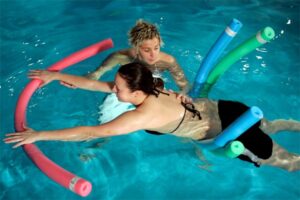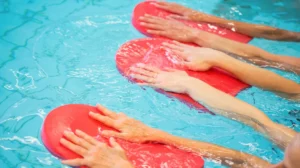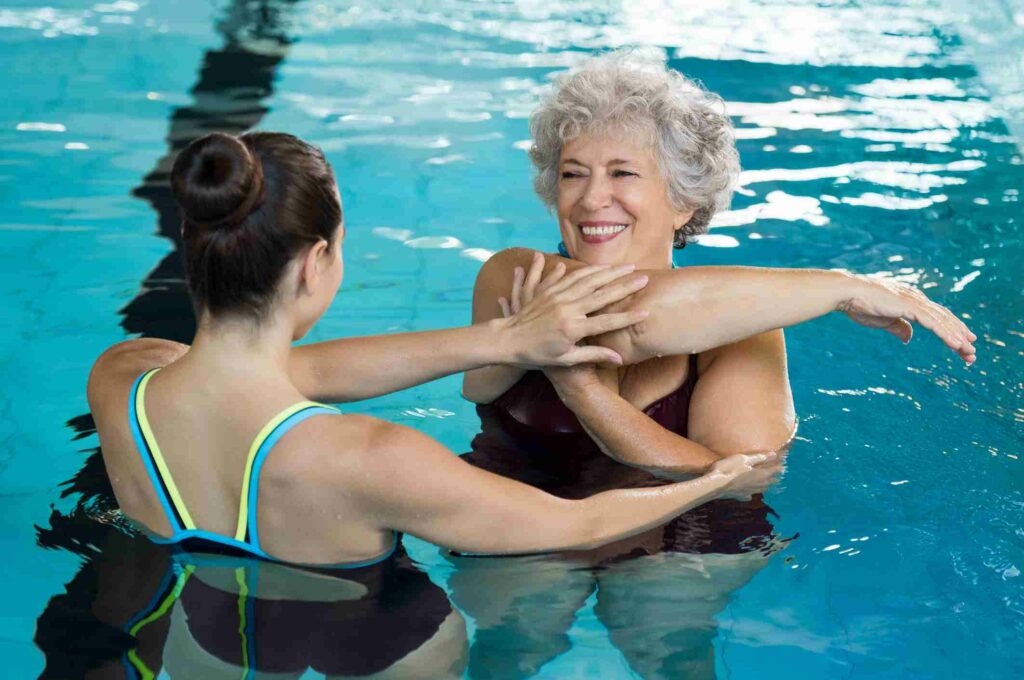Aquatic therapy is growing in popularity as a way to improve overall health and well-being. But what is it, exactly? Aquatic therapy is the use of water for rehabilitation purposes. This can include anything from using a pool for exercise to performing specific tasks underwater. However, this type of therapy can be adapted to any ability level, and there are many benefits to be had! In this blog post, we will discuss everything you need to know about aquatic therapy.
Contents
What Is Aquatic Therapy?
 Aquatic therapy also referred to as water therapy or hydrotherapy, is an effective form of physical therapy that utilizes the natural properties of water for therapeutic purposes. It has been used for centuries to treat a variety of conditions, from injuries and illnesses to chronic pain and mobility problems.
Aquatic therapy also referred to as water therapy or hydrotherapy, is an effective form of physical therapy that utilizes the natural properties of water for therapeutic purposes. It has been used for centuries to treat a variety of conditions, from injuries and illnesses to chronic pain and mobility problems.
The history of this type of therapy is long and varied, but it was first used by the ancient Greeks and Romans to treat a variety of illnesses and injuries. In modern times, aquatic therapy has become increasingly popular as a form of physical therapy for both adults and children alike.
If you are considering aquatic therapy, make sure to talk to your doctor first. With the right care and specialized physical therapist, you will more likely reap the benefits of aquatic therapy.
How Does It Work?
Aquatic therapy is a physical rehab technique used by healthcare professionals to treat people with various medical conditions. This type of therapy combines exercises, stretching, and other treatments that are done in water. The buoyancy of the water helps reduce joint stress and provides resistance for strengthening muscles.
This is divided into two components: hydrostatic pressure and turbulence. Hydrostatic pressure is the force created by water that helps to support the body, reduce swelling and inflammation, and improve balance. Turbulence is caused by movement in the water which can be used to increase resistance.
Techniques
There are also some techniques used during aquatic therapy that involve the use of water-based equipment. These include:
- Floating: This is done with a foam float or noodle that allows the patient to move in the water without any resistance. It can be used for stretching and range of motion exercises.
- Exercise Balls: These are pool balls that are used to help strengthen muscles and improve balance. They can also be used for core stability exercises.
- Aquatic Bikes: These are stationary bikes that are placed in the water and provide resistance while the patient pedals. This can be used to increase strength and endurance.
All in all, it is considered one of the best types of physical therapy for those who are suffering from pain, inflammation, and decreased range of motion. Aquatic therapy is a safe and effective way to help people improve their physical health and well-being.
What Are Some Aquatic Therapy Exercises?
When it comes to aquatic therapy, there are a variety of exercises that can be done in the pool. These exercises range from stretching and strengthening muscles, to balancing work and cardiovascular activities. Examples of these exercises include:
Walking in the water
This is a great way to build core strength and stability while giving the joints some relief from the pressure of walking on land. This exercise can be done with no additional equipment, or with flotation devices like buoys or noodles.
Jumping jacks
This exercise is a great way to increase your cardiovascular capacity, as well as improve overall body coordination. It’s also great for toning your legs and glutes. It might sound simple, but it’s surprisingly challenging when done in the water!
Upper body strength training
This can be done with the help of flotation devices such as buoys or noodles, which allow you to do a variety of exercises targeting different muscles in the upper body. Examples include rows, bicep curls, triceps dips, and shoulder presses. Buoys and noodles are lightweight, portable, and easy to use, making them ideal for aquatic therapy sessions.
Lower body strength training
This type of exercise is done with the aid of resistance bands or a swim belt that increases resistance in the water. Resistance training in a pool can help build strength while decreasing joint pressure thanks to the buoyancy of the water. Examples of lower-body exercises that can be done with aquatic therapy include squats, lunges, leg curls and calf raises.
These are just a few examples of how aquatic therapy can be used to help build muscle and strength. Waist-high wading pools, which are also known as therapeutic pools, can provide an even deeper level of resistance for those who need it.
Why Aquatic Therapy Is Important?
 There are many benefits to aquatic therapy. It is low impact, allowing for exercises that are safe for those with joint or mobility issues. The water provides support, reducing stress on the joints and muscles while providing resistance to help build strength.
There are many benefits to aquatic therapy. It is low impact, allowing for exercises that are safe for those with joint or mobility issues. The water provides support, reducing stress on the joints and muscles while providing resistance to help build strength.
Aquatic therapy can also reduce swelling and inflammation throughout the body due to the buoyancy of the water, helping to speed up the recovery process. Additionally, the warm water is often soothing and can help reduce muscle tension and pain.
So, if you are looking for a way to get fit and stay healthy without putting too much stress on your body, aquatic therapy may be the best option.
What Conditions Are Treated With Aquatic Therapy?
Well, this therapeutic, water-based exercise can be used to treat a variety of conditions and ailments. Aquatic therapy is often recommended for people with arthritis and rheumatoid diseases, as the water helps ease tension and joint swelling. Other conditions that are treated with aquatic therapy include:
- Back pain
- Obesity
- Sports injuries
- Stroke rehabilitation
- Cerebral palsy
- Lymphedema
- Fibromyalgia
- Multiple sclerosis
- Spinal cord injuries
- Muscle pain/strain
These are just a few of the conditions that may benefit from this type of therapy. The benefits depend on the individual’s needs and preferences, as well as the intensity and type of exercise used in treatment.
More often, it is advised to perform exercises specifically designed for aquatic therapy. This helps the client target specific areas of their body, as well as focus on improving strength and mobility.
What Are The Disadvantages Of Aquatic Therapy?
Generally, this is an effective form of therapy that doesn’t have many drawbacks, compared to other forms of physical therapy. However, there are a few cons to consider before starting your aquatic therapy regimen:
- It is not suitable for certain medical conditions. If you have an existing medical condition such as heart disease, obesity, or arthritis, it is important to discuss with your doctor whether aquatic therapy is right for you.
- Pool water temperature can be a problem, especially in the colder months. It is important to ensure that pool water is at the correct temperature before beginning aquatic therapy sessions.
- You need access to a heated swimming pool or therapeutic pool. Most swimming pools are not suitable and may not have the necessary equipment for an effective aquatic therapy session.
- Equipment and support are essential and must be provided by a qualified instructor. Aquatic therapy should never be attempted alone since it requires the guidance of an experienced professional.
Despite these disadvantages, this therapy remains one of the most successful forms of physical therapy for many people with chronic pain and mobility issues. With careful consideration of the pros and cons, this form of therapy can be a great way to improve your overall health and well-being.
How Often Should You Do Aqua Therapy?
 Many experts recommend attending aquatic therapy sessions two to three times a week for the best results. However, the frequency and duration of each session will depend on your condition and the severity of the symptoms. Your therapist can provide more detailed guidance on how often you should do aqua therapy.
Many experts recommend attending aquatic therapy sessions two to three times a week for the best results. However, the frequency and duration of each session will depend on your condition and the severity of the symptoms. Your therapist can provide more detailed guidance on how often you should do aqua therapy.
Because this type of therapy is low impact, there are fewer risks involved. Some people experience minor soreness or muscle aches after a session, but these should quickly subside.
Hence, the duration and intensity of each session can be tailored to meet your individual needs and help you reach your desired goal. With the right guidance and proper technique, aqua therapy can be an effective form of physical rehabilitation.
Conclusion
In a nutshell, aquatic therapy can be an incredibly effective way to treat a variety of physical and mental health conditions. It is a low-impact form of exercise that enables individuals to work on their strength, mobility, balance, and endurance while in the water. This therapy can also be used for therapeutic purposes such as improving coordination, etc.
Physical Therapy has always been proven to help patients recover from pain. Hence, if you’re experiencing Back pain, Shoulder pain, Knee pain, Neck pain, Elbow pain, Hip pain, or Arthritis pain, a physical therapist at MantraCare can help: Book a physiotherapy session.


